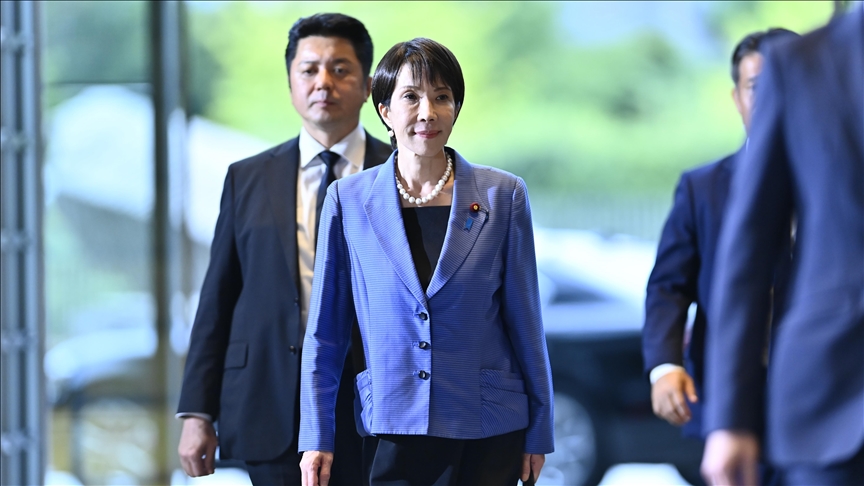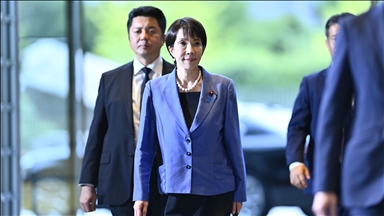Japanese markets give warm welcome to 1st female premier
Nikkei 225 closes day at record high as Sanae Takaichi elected
 Newly elected Japanese Prime Minister Sanae Takaichi arrives at her official residence in Tokyo, Japan, escorted by Security Police (SP) officers, shortly after being chosen by parliament as the country’s new leader, on October 21, 2025.
Newly elected Japanese Prime Minister Sanae Takaichi arrives at her official residence in Tokyo, Japan, escorted by Security Police (SP) officers, shortly after being chosen by parliament as the country’s new leader, on October 21, 2025.
- Nikkei 225 closes day at record high as Sanae Takaichi elected
- New LDP-Japan Innovation Party coalition aims to boost technology and reform public administration, but faces questions over fiscal discipline
- Analyst warns of potential friction with the Bank of Japan on inflation and interest-rate policy
ISTANBUL
Japanese markets surged this week as Sanae Takaichi was elected the country’s first female prime minister on Tuesday, signaling investor relief as weeks of political uncertainty gave way to a new government.
The Nikkei 225 jumped more than 3% on Monday after the ruling Liberal Democratic Party (LDP) reached a coalition deal with the conservative Japan Innovation Party (JIP) to form a government.
Following Takaichi’s victory in the 456-seat Lower House, where she won 237 votes to become Japan’s 104th prime minister, the index closed up a further 0.15% – hitting a record high as traders welcomed the prospect of stability and pro-growth policies.
Takaichi, 64, has pledged that her immediate focus will be on improving Japan’s economy.
But optimism was tempered by questions over fiscal discipline and monetary policy, with investors weighing the new government’s ambitious spending and tax-cut plans against the Bank of Japan’s cautious stance on inflation.
Sadi Kaymaz, an Asia markets expert, told Anadolu that markets see strong potential in the LDP–JIP coalition, particularly for Japan’s tech and manufacturing sectors.
“Investments in strategic areas like artificial intelligence and robot technologies are expected to accelerate,” he said. “Companies like Fanuc, Lasertec, and Tokyo Electron on the Tokyo Stock Exchange responded positively to these developments, with shares rising as high as over 6%.”
However, he added that while the coalition’s growth agenda may boost confidence, its fiscal impact will be closely monitored.
New coalition, new priorities
The new coalition marks a major political realignment following the collapse of the decades-long LDP-Komeito partnership.
Komeito, backed by the Buddhist organization Soka Gakkai, had long been regarded as Japan’s “party of peace,” favoring restraint in defense spending and fiscal conservatism. Its departure left the LDP seeking new allies to retain a parliamentary majority.
The JIP, also known as Nippon Ishin, has taken a different stance – emphasizing economic reform, administrative efficiency and fiscal responsibility. It brought the simplification of public administration to the fore as one of the key agenda items in coalition talks.
“The JIP says Japan should not deviate from its target of a primary budget surplus in 2027,” he said. “And markets are reacting positively to them as a balancing factor in the coalition.”
Still, questions remain about the stability of the alliance, as the JIP has said it will support the LDP but take no ministerial posts in the Cabinet.
Potential clash with central bank on inflation
Kaymaz noted that while the Japanese government has traditionally avoided direct intervention in central bank decisions, the two institutions have collaborated.
“The issue is the fundamental difference in how they view inflation,” he said. “Takaichi believes that price growth remains weak because of weak demand, which is why she considers growth-oriented policies to be essential in leaving the deflationary past behind.”
The Bank of Japan, however, has expressed concern over rising inflation expectations and the risk of overheating.
“This points to a potential conflict in monetary and fiscal policy,” he said.
Japan’s inflation rate stood at 2.7% in October, above the central bank’s long-standing 2% target, prompting speculation that policymakers could tighten rates sooner than expected.
However, for most of the past 30 years, Japan’s inflation has remained below target – something Takaichi does not want to return to prematurely through higher interest rates.
Tax cuts versus fiscal discipline
Despite the coalition’s moderating presence, Takaichi’s focus on economic stimulus, including tax cuts, has raised concerns about fiscal sustainability.
“The new administration’s approach to tax cuts is among many issues causing concern in the markets, as the long-term debt outlook could deteriorate if spending is done via tax cuts,” Kaymaz said.
He noted that investors are monitoring the selling trend in long-term bonds.
“Former LDP leader and premier Shigeru Ishiba’s administration was characterized by fiscal discipline and a resistance to tax cuts despite the increase in living costs,” he added.
Kaymaz said the possibility of a rate hike at the BoJ’s meeting at the end of October stands at about 25% in the swap markets.
Yet despite points of market caution and the political shake-up, optimism remains high.
The Nikkei index has climbed more than 25% this year on expectations that Japan’s technology-driven economy can continue expanding even amid global headwinds, including higher US tariffs.
First Japanese female premier, 'Iron Lady'
Japan's ruling Liberal Democratic Party (LDP) President Sanae Takaichi on Tuesday secured victory in both chambers of the bicameral parliament to become the country’s first female prime minister.
The 64-year-old, nicknamed “Iron Lady,” plans to revive the economy with tremendous government spending. Preparations are underway to elect a new prime minister in Japan after Prime Minister Shigeru Ishiba’s resignation last month.
She advocates for expansionary government budgets and loose monetary policy as key drivers for growth and corporate profits, saying that her goal is to solve social issues, develop technology, boost employment and reduce debt via public-private investments and natural tax revenue growth.
Anadolu Agency website contains only a portion of the news stories offered to subscribers in the AA News Broadcasting System (HAS), and in summarized form. Please contact us for subscription options.







